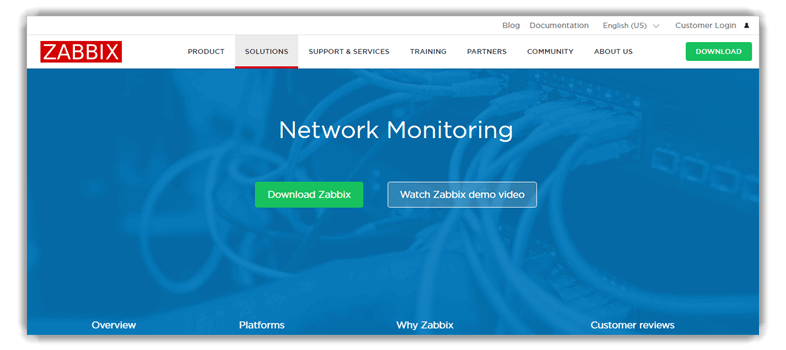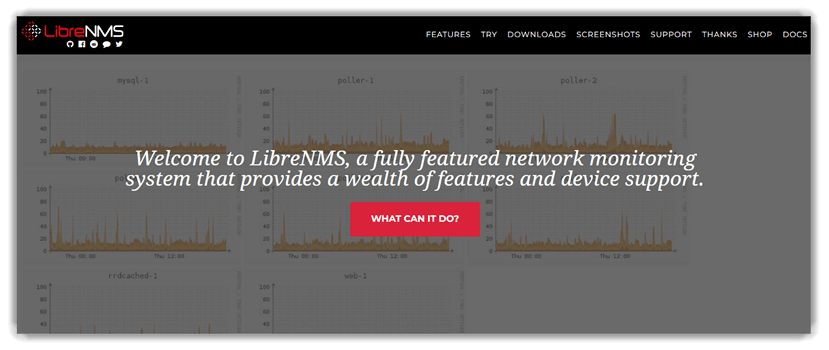10 BEST System Monitoring Software Tools (2025)
A System Monitoring tool is a software that tracks the resources and performance of any system. The main reason for using a system monitoring tool is to detect the system issues, identify the root cause, and get them resolved quickly. It helps you to visualize your network by using real-time heatmaps with live status information.
After spending over 80 hours on an in-depth analysis of 30+ Best System Monitoring Software Tools, I am presenting this insightful guide featuring free and paid options for your convenience. My professional and well-researched article showcases comprehensive comparisons of features, pricing, and reliability—all you need to make a credible choice. This must-see article may help you uncover the perfect tool. Read on for exclusive and trusted details. Read more…
ManageEngine OpManager is a unified network systems monitoring and management solution for efficient and seamless IT Operations Management. This tool is suitable for enterprises, distributed networks, SMBs, etc.
Best System Monitoring Software & Tools
| Name | Free trial | Deployment | Pricing | Links |
|---|---|---|---|---|
 ManageEngine OpManager |
30-Days Free Trial | Web-based and Cloud-based | Request a Quote from Sales. | Learn More |
 Site24x7 |
30-Days Free Trial | Web-based and Cloud-based | $9 a month. | Learn More |
 PRTG Network Monitor |
Download for free | Web-based and Cloud-based. | $2149 a year. | Learn More |
 Network Monitoring Software |
30 Days Free Trial | Web-based and Cloud-based | Request a Quote from Sales | Learn More |
 Teramind |
14-Days Free Trial | Web-based and Cloud-based | $14/seat/month | Learn More |
1) ManageEngine OpManager
ManageEngine OpManager is an all-in-one monitoring tool. During my research, I found it excellent for tracking network systems effectively. It is great for small businesses, distributed networks, and enterprises. OpManager supports standards like HIPAA, SOX, PCI, and Cisco IOS. In fact, it helped me with ICMP, TCP, and SNMP protocols. I particularly liked the instant email and SMS alerts it provides. Its compatibility with Windows, Android, and iOS platforms is very helpful.
Integrations: ServiceNow, Zendesk, Jira and Freshservice
Alerts: Email and SMS
Supported platforms: Windows, Android and iOS
Free Trial: 30 Days Free Trial
Features:
- Network Visualization: I find the dashboards and heat maps perfect for providing a complete summary of network status.
- Performance Monitoring: Unified network, server, VM, switch, router, WLC, and hardware monitoring for efficient performance management.
- Application Performance: With the ManageEngine plug-in, I can effectively monitor both on-premise and cloud applications for optimal performance.
- Integration Capabilities: Integrates seamlessly with ServiceNow, Zendesk, Jira, and Freshservice, offering great options for enhanced support workflows.
- Language Support: Supports multiple languages like English, French, German, Japanese, Polish, Spanish, Chinese, Turkish, and Portuguese, ensuring ease of use globally.
- Advanced Features: Multi-level thresholds, custom dashboards, workflow automation, VoIP monitoring, root cause analysis, and high availability options included.
Pricing:
- Price: Request a Quote from Sales.
- Free Trial: 30 Days Free Trial
30-Days Free Trial
2) Site24x7
With Site24x7’s all-in-one monitoring platform, eliminate server outages and performance issues by constantly tracking key performance indicators of application servers, mail servers, web servers, virtual servers, database servers, and more.
Site24x7 seamlessly integrates with various tools like Nagios, MySQL, Redis, Slack, Jira, and Zoom. I have found that it supports compliance standards such as SOC and provides protocols like HTTP, FTP, SIP, SMTP, NNTP, and XMPP, making it an ultimate solution for monitoring needs. During the period of my assessment, I particularly liked its customizable reporting and device, global, and email templates.
Integrations: Nagios, MySQL, Redis, Slack, Jira and Zoom
Alerts: Email and SMS
Supported platforms: Windows, Android and iOS
Free Trial: 30 Days Free Trial
Features:
- AI-based Forecasts: Avoid incidents with AI and ML-based metric forecasts, auto-remediating issues, which typically reduces risks.
- Endpoint Monitoring: Monitor diverse client endpoints, networks, and Server monitor from a single platform, which helps you avoid complexities.
- Real-Time Alerts: I receive real-time alerts via email, SMS, voice calls, and push notifications to stay updated quickly.
- Log Collection: Collect logs for servers, applications, and network devices to troubleshoot issues, which allows you to resolve them faster.
- Custom Dashboards: View performance metrics using customized dashboards, providing deeper visibility into server health and overall efficiency
Pricing:
- Price: Plans start at $9 a month.
- Free Trial: 30 Days Free Trial
30-Days Free Trial
3) PRTG Network Monitor
PRTG Network Monitor is a system monitoring tool that helps you check all the devices, systems, traffic, and applications in your I.T. infrastructure. It is a suitable business solution for organizations of all sizes.
I discovered that PRTG Network Monitor can easily scan specific I.P. ranges to detect problems, offering quick alerts when something unusual occurs. It seamlessly integrates with popular tools like GitLab, which I personally recommend for teams that need a smooth workflow. I also found that it supports multiple protocols, including NetFlow and IPFIX, making it one of the best network monitoring solutions. It provides instant alerts via email or push notifications and supports languages like English, German, French, and Spanish, which is essential for global users. It offers excellent customer support and compliance with GDPR, making it a top-rated tool for businesses aiming to ensure network security.
Integrations: GitLab, MIDAS, Unimus, Ekara and Freshservice
Alerts: Email and Push
Supported platforms: Windows, Linux and Mac
Free Trial: 30 Days Free Trial
Features:
- Custom Web Pages: You can create web pages showing real-time monitoring data, which is a great way to share insights.
- Network Visualization: Visualize your networks with real-time maps showing live status and historical data for deeper insights.
- Live Heatmaps: I use real-time heatmaps to monitor network performance, which helps me stay proactive with live data.
- Failover Notifications: Allows failover-tolerant monitoring with notification alerts, which is a great way to avoid critical failures.
- Advanced Reporting: It provides SLA reports, customizable interfaces, intelligent discovery, and distributed monitoring for comprehensive system management.
Pricing:
- Price: Starts at $2149 paid annually
- Free Trial: Download for free
Download for free
4) Network Monitoring Software
Network Monitoring Software is a remarkable platform that I checked for its monitoring features. It offered me SNMP and WMI protocol support, which is required for network observability. Network Monitoring Software also provides customer support via chat, phone, and email, which is one of the easiest ways to get assistance. The platform also supports platforms like Android, Windows, and Linux, making it one of the best choices for diverse systems.
Integrations: Jira, Zendesk and Jira
Alerts: Email
Supported platforms: Android, Windows and Linux
Free Trial: 30 Days Free Trial
Features:
- Network Application Bandwidth: Identify which network applications use the most bandwidth, which helps optimize performance and avoid slowdowns.
- Path Changes & Issues: I monitor changes along the path, which helps me find and address issues with my service provider more effectively.
- Device Path Analysis: Provides visual analysis of device delivery paths and sends email alerts instantly when issues are detected.
- Fault Monitoring & Metrics: This application monitors network faults, allowing performance metrics to be placed on a timeline for better insights.
- SDN Logical Components: Monitor the logical components of SDN, which is helpful to improve network management efficiency and performance.
Pricing:
- Price: Request a Quote from Sales.
- Free Trial: 30 Days Free Trial
Link: https://www.solarwinds.com/network-performance-monitor/
5) Nagios
Nagios is a network monitoring tool that helped me identify and resolve I.T. infrastructure issues effectively. It allowed me to pinpoint problems before they could affect my business processes. During the period of my assessment, I found it great to offer diagnostics with an engineer’s toolset and customizable reporting. It provides support for compliance standards such as HIPAA and SOX, making it perfect for maintaining industry standards. The superior features, like customizable templates, along with platform support for Windows and Ubuntu, make Nagios a top choice for network management.
Features:
- Dashboard Insights: This system monitoring software offers detailed insights on network traffic and bandwidth, helping me analyze overall network health.
- Network Flow Tracking: Allows you to monitor specific network flow subsets for better visibility, planning, and issue remediation.
- Chart Display Options: Provides flexible result displays in ribbon, bar, column, step, or area charts, enhancing data interpretation.
- Advanced User Alerts: It is great for sending alerts during abnormal activity and helps I.T. teams collaborate effectively.
- Seamless Integration: Integrates with AKCP, Fedora, VMware, SUSE, CentOS, Debian, and ServiceNow for uninterrupted monitoring support.
Pricing:
- Price: Request a quote from sales
- Free Trial: Lifetime free basic plan
Link: https://www.nagios.org/
6) LogicMonitor
LogicMonitor is an automated SaaS network testing tool. It is one of the best network monitoring tools that offer customizable dashboards, alerts, and reports. This tool can identify incoming issues by providing predictive alerts and trend analysis.
LogicMonitor is a top-rated monitoring solution for SD-WAN and cloud-based networks. During the period of my assessment, I found its wireless access-point monitoring very helpful to ensure uninterrupted connectivity. It offers instant alerts via email and SMS and supports multiple languages, which makes it perfect for diverse teams. The alert and dashboard templates make network management simpler. The support for Windows and Mac makes it suitable for varied environments.
Features:
- Network Device Discovery: One of the best tools for discovering all network devices and interfaces, helping maintain network visibility.
- Hardware Monitoring: Monitors CPU, memory, and temperature via SNMP, NetFlow, and WMI, which helped me maintain optimal hardware performance.
- Seamless Integration: Seamlessly integrates with platforms like Azure, Kubernetes, Zoom, and VMware, offering one of the best multi-platform solutions.
- Advanced Data Features: Provides data retention, forecasting, and anomaly detection, offering a great way to optimize network management.
- Custom Reports & Dashboards: Offers customizable reports, maps, and dashboards to visualize network metrics in the most effective way.
Pricing:
- Price: Plans start at $22 a month.
- Free Trial: 14 Days Free Trial
Link: https://www.logicmonitor.com/
7) Spiceworks Network Monitor
Spiceworks Network Monitor is one of the best free network testing tools that I have personally tried. I appreciate how simple it is to install and how quick the setup process is. I could start monitoring my devices within minutes. It allows you to receive alerts whenever critical network changes happen. I particularly like that it integrates smoothly with TeamViewer and supports important standards like GDPR. The tool also supports both TCP and UDP protocols, making network communication seamless. It also supports multiple platforms like Windows, Linux, and Mac.
Features:
- Alert Thresholds: You can adjust alert thresholds for in-app notifications or emails, allowing personalized monitoring.
- Real-Time Alerts: Provide real-time up/down status alerts about critical web applications and services for faster resolution.
- Tool Integration: It offers full integration with the Spiceworks IT management cloud suite, a great option for IT management.
- Support Channels: Provides online, phone, and chat support and helps you with customer queries via email or contact form. I benefited from the quick responses via email and chat.
- Data Features: Offers Distributed HTTP check, dynamic dashboard, global data distribution, and customizable reports for better scalability.
Pricing:
- Price: Free Forever plan
Link: https://www.spiceworks.com/free-network-monitoring-management-software/
8) Zabbix
Zabbix is a network monitoring tool I reviewed, and I was impressed by its range of features. I particularly appreciated how it monitors I.T. infrastructure, services, applications, and network resources with ease. I could access real-time alerts through email and SMS, which helped me stay on top of issues. During my research, I found that advanced problem detection was very helpful in identifying and resolving issues quickly. The tool supports agents on most platforms, which makes it ideal for managing various environments like Windows, Linux, and Mac.
Features:
- Multi-Metric Collection: Collect metrics from devices, systems, and applications using one of the most effective multi-metric methods. I was able to gather system metrics from multiple sources easily.
- Data Visualization: Provides visualization with customizable dashboards, maps, and graphs, perfect for monitoring system performance.
- Quick Deployment: It uses out-of-the-box templates to simplify deployment, which is a great way to save time in setup.
- Integration Capability: Integrates seamlessly with APC, JIRA, Jenkins, and GitLab, allowing you to streamline workflows easily.
- Scalable & Secure: Offers unlimited scalability, high availability, and task automation to ensure secure and efficient operations.
Pricing:
- Price: Free Download
Link: https://www.zabbix.com/network_monitoring
9) LibreNMS
I checked LibreNMS, a flexible network monitoring system, and it was great for auto-discovering devices through SNMP. I particularly liked its support for protocols like OSPF, which improved monitoring. The tool made setup easy with pre-built templates, and the multiple user interfaces, including maps, allowed me to visualize network data. Real-time alerts came through email and Slack, which was incredibly helpful. I suggest LibreNMS for anyone needing a reliable tool.
Features:
- Custom Alerts: A highly flexible alerting system sends notifications via Slack, email, and IRC, which helps avoid missing critical updates. I appreciated the flexibility in alert options, especially via email and Slack.
- Responsive Dashboard: Features a mobile-friendly, customizable dashboard that is great for real-time monitoring from any device.
- Update Automation: Automatically update with bug fixes and new features, one of the easiest ways to ensure efficiency.
- Data API: Offers full API support to manage, graph, and retrieve data, a great way to visualize system metrics.
- Tool Integration: Seamlessly integrates with platforms like NfSen, collected, and Graylog, which is helpful in unifying system monitoring.
Pricing:
- Price: free and open-source software
Link: https://www.librenms.org/
10) Pandorafms
Pandora FMS is a powerful employee monitoring software I tested, and I was impressed by its ability to manage both network monitoring and I.T. issues. I particularly liked the built-in KPI and SLA metrics, which provided me with clear performance insights. The GIS tracking feature helped me view geographic data efficiently. With instant alerts and multiple language support, Pandora FMS is great for international teams, and it works perfectly on Windows and Linux systems.
Features:
- WYSIWYG Dashboards: Offers visual console screens with WYSIWYG functionality and multi-layer access control, perfect for managing complex setups.
- Real-Time Tracking: Allows real-time tracking and network analysis, which helped me monitor and maintain optimal system performance.
- Cross-Platform Integration: Seamlessly integrates with platforms like Zimbra, WebLogic, SAP, and Azure, offering great compatibility for enterprise systems.
- Compliance Standards: Supports important compliance standards like ISO and HIPAA, ensuring all you need for security and regulatory adherence.
- Scalability & Security: Provides high scalability, distributed environments, security monitoring, and customizable reporting for effective system management.
Pricing:
- Price: Request a quote from sales
- Free Trial: 30 Days Free Trial
Link: https://pandorafms.com/network-monitoring/
What is System Monitoring Software?
A System Monitoring Software is a tool that tracks the resources and performance of any system. The main reason for using system monitoring software is to detect the system issues, identify the root cause, and get them resolved quickly. It helps you to visualize your network by using real-time heatmaps with live status information.
How Did We Choose Best System Monitoring Software?
At Guru99, we prioritize credibility by ensuring accurate, relevant, and objective information through rigorous content creation and review. After spending over 80 hours analyzing 30+ system monitoring tools, I present this guide featuring free and paid options, with comprehensive comparisons of features, pricing, and reliability to help you make an informed choice. Selecting the right system monitoring tools can be challenging, so we focused on key factors to provide you with the most efficient options, ensuring reliable and optimized performance.
- Monitoring multiple servers: Your system monitoring software should be able to handle servers from different vendors running various operating systems. It should also be able to monitor from various servers at multiple sites and in cloud environments.
- Monitoring range of server metrics: It should offer various metrics like CPU usage, memory usage, disk space, upload/download rates, Monitoring CPU temperature, etc.
- Monitoring applications: It should provide common monitoring applications using a deep knowledge that helps you to monitor key server processes, including web servers, database servers, and application stacks.
- Automatic alerting: The most important and vital feature of any system monitoring tool is to provide automatic alerts when servers or network devices are down or overloaded.
- Triggering actions in response to alerts: It should help to handle specific classes of network problems automatically.
- Collection of historical data: Should be able to collect historical data about the server and device health and behavior.
- Reports: It should allow generating useful predefined reports that help with tasks like optimizing resource usage and forecasting capacity.
- Customizable reporting: It should help you to create customized reports.
- Easy configurability: A System monitoring software should be easy to configure and install on complex network infrastructures.
- Scalability: It should be able to grow with your business requirements, from a small or medium business (SMB) to a large enterprise.
What are the types of system monitoring software?
There are Seven types of system monitoring software:
- Performance monitors: Processors of Simple Network Management Protocol (SNMP) status messages.
- Performance testers: These type of software issue commands, such as ping and traceroute, to gather statistics.
- Wireless sniffers: Are the packet sniffers or packet analyzers for wireless networks.
- Firewalls: Read packets traveling through the network boundary.
- Intrusion detection systems: Help you to identify standard and anomalous traffic patterns.
- SIEM tools: This type of system monitoring tools examine log files for security breaches.
What are the best practices for System monitoring?
When using network infrastructure monitoring tools, you need to keep in mind the following best practices. By implementing these, you can boost the success of your network infrastructure monitoring strategy.
- Prioritize: Before establishing notification or threshold settings, you need to determine which components are most important.
- Create alert resolution processes: You should always try to achieve the fastest and most efficient resolution for each type of alert you set up. This should be tied in with prioritization and should consider escalation.
- Practice redundancy: If you have several data centers, make sure you are monitoring each of them from multiple locations.
- Combine monitoring tools: You will get on-premises and cloud-based tools. Use both if it is necessary.
- Keep tabs on the monitor: Never assume that just because you are not getting alert messages, nothing is wrong in your system. There could be an issue with the monitoring tool itself or in the system settings.
- Review metrics on a regular basis: The thresholds you establish can be too high or too low. However, if you are receiving plenty of alerts or you aren’t notified when a problem in your system occurs, so you should change your threshold settings.
- Conduct tests: You need to find out whether your alert system is effective when a critical issue arises. You need to do it only once when you implement a monitoring and alert system. It needs some fine-tuning. For that, you need to conduct regular tests so the robustness and effectiveness of the system remain efficient before a specific issue occurs.
What are the Network Monitoring Techniques?
Network monitoring uses a variety of techniques to test the availability and functionality of the network. Some more common techniques used to collect data for monitoring software are:
- Ping: Ping monitoring tools send signals and record data, like the signal was received or not and how long it took the host to receive that signal.
- SNMP: SNMP monitors individual devices in a network through monitoring software.
- Syslog: Syslog is an automated messaging system that sends messages when a specific event affects a network device.
- Scripts: In networks, scripts are used to substitute for any lack of functionality in network monitoring software.
FAQs
Verdict
System monitoring software is essential for tracking performance, detecting issues, and maintaining optimal operation of IT systems. I find the tools I reviewed to be powerful in delivering comprehensive monitoring capabilities. Check my verdict below.
- ManageEngine OpManager for its secure, customizable monitoring with impressive real-time performance insights.
- Site24x7 is a robust, user-friendly tool ideal for monitoring endpoints and servers across platforms.
- PRTG Network Monitor is a system monitoring tool that helps you check all the devices, systems, traffic, and applications in your I.T. infrastructure.
ManageEngine OpManager is a unified network systems monitoring and management solution for efficient and seamless IT Operations Management. This tool is suitable for enterprises, distributed networks, SMBs, etc.









